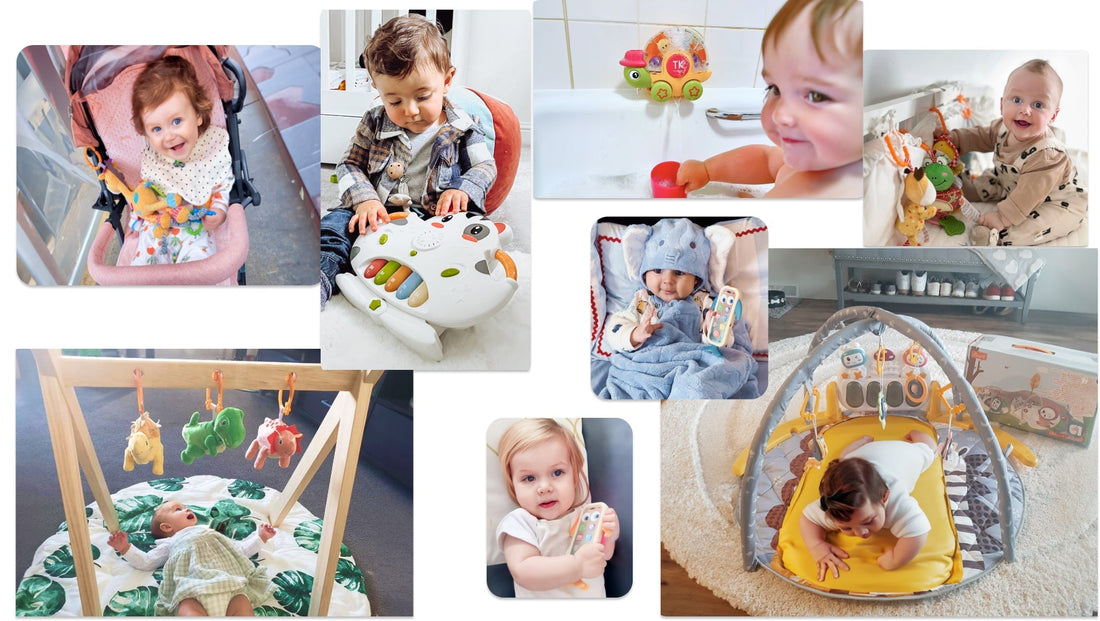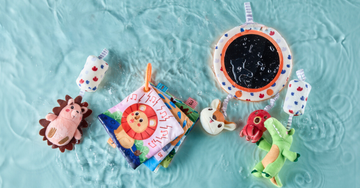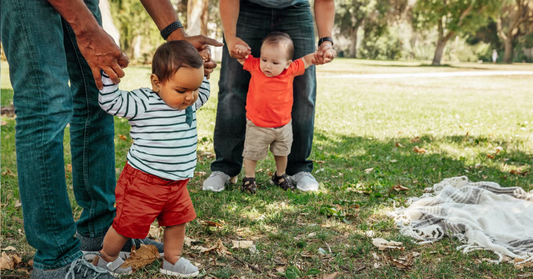Quando os bebês começam a brincar com brinquedos?

Bem-vindos à maravilhosa jornada da paternidade! Ver seu filho crescer e aprender é uma das maiores alegrias da vida. Como pais de primeira viagem, vocês podem ter muitas perguntas sobre o desenvolvimento do seu bebê, e uma delas é: quando os bebês começam a brincar com brinquedos?
Brincar é uma parte vital do crescimento do seu bebê, ajudando-o a explorar o mundo, desenvolver habilidades essenciais e criar laços com você. Neste guia, exploraremos quando os bebês geralmente começam a brincar com brinquedos, quais tipos de brinquedos são mais adequados para cada fase da vida e como os brinquedos contribuem para o desenvolvimento físico, cognitivo e emocional do seu filho.
Quando os bebês começam a brincar com brinquedos e estágios de desenvolvimento
Do nascimento aos 3 meses: observando e explorando
Nos primeiros meses de vida, seu bebê se concentra em descobrir seu novo mundo. Ele é míope e se interessa mais por rostos, padrões de alto contraste e objetos próximos. Nesta fase:
- Principais marcos: Apreensão reflexiva, rastreamento de objetos com os olhos e resposta a sons.
- Brinquedos para experimentar: Chocalhos suaves, celulares de alto contraste, brinquedos estampados em preto e branco e tecidos texturizados.
- Ideias para brincar:
- Segure um brinquedo a cerca de 20 a 30 cm do rosto do bebê e mova-o lentamente para incentivar o rastreamento ocular.
- Hora da barriga com tapetes texturizados para fortalecer os músculos do pescoço e dos braços.
- Faça expressões faciais exageradas e converse com seu bebê para promover laços sociais.
3 a 6 meses: Alcançar e agarrar
Nesta fase, os bebês começam a ganhar melhor controle dos braços e das mãos. Eles pegam os brinquedos, os agarram e os levam à boca para explorá-los.
- Principais marcos: Melhora da visão, coordenação motora e capacidade de alcançar e segurar objetos.
- Brinquedos para experimentar: Brinquedos macios e fáceis de segurar, como chocalhos, mordedores e brinquedos com sons ou texturas.
- Ideias para brincar:
- Demonstre como sacudir um chocalho e depois deixe seu bebê tentar.
- Coloque os brinquedos ao alcance da criança durante o período de bruços para incentivar o alongamento e a pega.
- Apresente brinquedos com sons suaves ou cores brilhantes para estimular os sentidos.
6 a 9 meses: Explorando e interagindo
Os bebês se tornam mais ativos e curiosos durante essa fase. Conseguem sentar-se sozinhos, transferir objetos entre as mãos e começar a engatinhar.
- Principais marcos: Sentar-se, passar brinquedos entre as mãos e reconhecer a permanência dos objetos.
- Brinquedos para experimentar: Empilhar brinquedos, livros macios, tapetes de atividades, e bolas rolando.
- Ideias para brincar:
- Brinque de esconde-esconde ou esconda um brinquedo parcialmente sob um cobertor para apresentar permanência do objeto.
- Incentive o engatinhar rolando uma bola ou colocando um brinquedo um pouco fora do alcance dele.
- Leia livros macios com texturas e imagens brilhantes para estimular a exploração visual e tátil.
9 a 12 meses: Mudança e resolução de problemas
Seu bebê agora está em movimento! Seja engatinhando, andando ou com apoio, ele está explorando o mundo de novas maneiras. A brincadeira se torna mais interativa e focada na resolução de problemas.
- Principais marcos: Engatinhando, se levantando e começando a andar.
- Brinquedos para experimentar: Empurre brinquedos, monte modelos, empilhe anéis e faça de conta que precisa brincar, como utensílios de brinquedo ou bonecas.
- Ideias para brincar:
- Incentive o movimento com brinquedos que rolam ou andadores.
- Introduzir quebra-cabeças simples e jogos de empilhamento para desenvolver habilidades de resolução de problemas.
- Brinque de faz de conta com bichinhos de pelúcia ou comida de brinquedo para despertar a criatividade.
O papel da brincadeira no desenvolvimento do bebê
Brincar é muito mais do que apenas entretenimento para o seu bebê — é uma parte fundamental do seu desenvolvimento. Através da brincadeira, os bebês:
- Desenvolva habilidades cognitivas: Ao explorar causa e efeito (e.g., sacudindo um chocalho), entendendo a permanência dos objetos e resolvendo problemas simples, os bebês desenvolvem suas habilidades de pensamento.
- Melhorar as capacidades físicas: Desde agarrar e alcançar até engatinhar e andar, brincar ajuda a desenvolver coordenação e força.
- Promova habilidades emocionais e sociais: Brincar fortalece os laços com os cuidadores e estabelece a base para a comunicação e o reconhecimento emocional.
A introdução de brinquedos adequados à idade no momento certo apoia esses marcos de desenvolvimento, garantindo que seu bebê aproveite ao máximo playtime.For mais informações, leia nosso guia sobre por que a brincadeira das crianças é importante e Por que a brincadeira sensorial é importante para bebês?
Dicas para escolher os brinquedos certos
Escolher os brinquedos certos pode melhorar a experiência de brincadeira do seu bebê. Aqui estão algumas dicas para manter em mente:
- Concentre-se em opções adequadas à idade: Procure brinquedos etiquetados com a faixa etária do seu bebê.
- Estimule múltiplos sentidos: Opte por brinquedos com cores brilhantes, texturas e sons suaves.
- Priorize a segurança:
- Evite bordas afiadas e peças pequenas que possam causar risco de asfixia.
- Escolha materiais macios, leves e laváveis.
- Evite tintas ou materiais tóxicos.
- Incentive a exploração: Brinquedos que promovem a aprendizagem de causa e efeito (e.g., um brinquedo que emite um som quando pressionado) são excelentes para desenvolver habilidades cognitivas.
Percepções do mundo real dos pais
Os pais costumam compartilhar histórias únicas e identificáveis sobre as preferências de brincadeira dos seus bebês. Aqui estão algumas histórias reais:
- Brinquedos favoritos: Muitos bebês adoram chocalhos e brinquedos que fazem barulho. Os pais observam que eles costumam ser mastigados tanto quanto brincam com eles.
- Interesses inesperados: Ventiladores de teto, papel amassado e itens que não são brinquedos, como controles remotos ou xícaras de café, costumam fascinar os bebês.
- Crescimento pessoal: Os bebês muitas vezes parecem desinteressados em brinquedos em um dia, mas demonstram saltos repentinos em brincadeiras e exploração no dia seguinte. O desenvolvimento pode acontecer da noite para o dia!
Incentivando a brincadeira: dicas para pais
Seu papel como pai ou mãe é crucial para fomentar o amor pela brincadeira. Veja como você pode incentivar seu bebê:
- Brinquem juntos: Participe das brincadeiras do seu bebê para criar vínculos e modelar comportamentos.
- Gire os brinquedos: Mantenha os brinquedos novos e interessantes trocando-os a cada poucos dias.
- Use itens domésticos: Objetos do cotidiano, como colheres de pau e caixas de papelão, podem ser reaproveitados para brincadeiras criativas.
- Priorize a segurança: Sempre supervisione as brincadeiras e mantenha objetos que possam causar asfixia fora do alcance delas.
Conclusão
Brincar é uma parte fundamental do crescimento e desenvolvimento do seu bebê. Da curiosidade do recém-nascido à brincadeira interativa, cada etapa traz marcos emocionantes para celebrar. Lembre-se: cada bebê é único, então abrace a jornada individual do seu filho e valorize esses momentos preciosos.
Se você tiver dicas ou histórias sobre quando seu bebê começou a brincar com brinquedos, adoraríamos ouvi-las nos comentários abaixo. Vamos compartilhar e aprender uns com os outros para tornar a maternidade ainda mais gratificante!
Explore nosso Brinquedos para bebês de 0 a 6 meses linha de brinquedos que seu bebê vai adorar.







0 Comentários